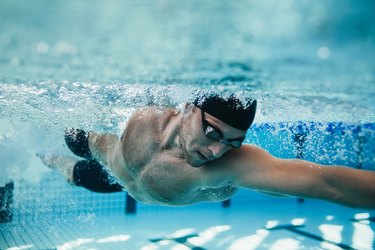
Though fish and little kids make gliding through the water look effortless, swimming takes full-body strength and coordination. You need to move your legs and arms in tandem, as well as time your breathing and strokes for maximum efficiency.
Other basic skills in swimming include diving into the water to get a smooth start on your stroke and sculling, which gives you a feel for how to properly move through the water. Once you feel confident moving around in the water, you can start learning basic swimming strokes such as breaststroke and butterfly.
Video of the Day
Video of the Day
Related Reading
1. Breathing Properly
Often overlooked among swimming skills is the ability to time your breaths with your strokes. When learning to breathe while swimming, beginners tend to lift their heads above the water when they run out of air and gasp for more.
But breaking your rhythm while swimming slows you down and tires you out. And if you don't know how to breathe while swimming, you'll struggle to make smooth, coordinated movements.
The basic idea involves breathing out through both your nose and mouth when your head is underwater, then lifting your head to the side and taking a full breath before plunging your face back down under the surface. Practice this motion when holding onto the side of the pool with your arms outstretched.
- Stand in chest-deep water in the pool, facing the wall, hands on the pool edge.
- Bend over at the waist, breathe in and place your face in the water.
- Slowly but forcefully blow out the air in your lungs through your nose and mouth.
- Rotate your head as you exhale, tilting it to the side, toward the surface of the water.
- When your cheek and mouth emerge above water, inhale. Don't gasp or lift your head too high.
- Repeat the exercise, breathing to the left and then to the right side.
Tip
Once you're comfortable breathing while holding onto the edge of the pool, try the same breathing pattern while holding onto a kickboard, using just your legs to propel you through the water as you practice breathing.
Alternatively, you can place a pull-buoy (a peanut-shaped foam float that keeps your legs afloat) between your thighs so that you can focus on pairing just your upper body movements with your breath.
2. Sculling
Sculling while swimming gives you a feel for moving through the water and keeps you from sinking in the water. It's one of the first safety skills beginners learn, yet expert synchronized swimmers and water polo players also depend on sculling.
- While positioned horizontally in the water (on your belly), move your hands — palms down and fingers below the wrists — in a circular or figure-eight motion just under the surface of the water, exerting pressure downward.
- Place a pull-buoy between your thighs so you don't need to kick.
- For a forward scull, keep your straight arms in front of you. For a mid scull, bend your elbows slightly with your hands wider than your shoulders.
Tip
By subtly varying the tilt of your forearms and palms, you determine whether you move forward, backward or stay in one place. When you tilt your forearms and palms back toward your body slightly, you propel yourself forward.
3. Coordinating Your Actions
Beginning swimmers often find themselves messily chopping through the water with their limbs. That's fine. It takes a while to get a feel for moving your limbs in time. You must also get used to moving the muscles in your lower back, abdomen and hips to power you forward.
Similarly, try to let your legs come up behind your body and keep a slim, streamlined position. Over time, this reduces drag from the water and makes you a more efficient swimmer.
4. Learning Strokes
Once you feel confident with basic swimming skills, mastering a specific stroke is your next challenge. Breaststroke, while requiring slightly more coordination than front crawl, offers a stable, gentle stroke that's ideal for beginners.
- Stay straight at the water's surface, holding your head up.
- Pull your arms in together with the hands almost touching.
- As your hands reach your chest, bend your knees and lift your feet up in a frog-like shape with the soles of your feet pointed out to each side.
- Push back with your legs and reach forward with your hands simultaneously. This double-propulsion should help you surge through the water.
Swimming statistics show the sport became a part of the Olympic Games in 1896. The first events were the freestyle and breaststroke, according to the Olympics website.
5. Diving
Diving into the pool is one of the necessary swimming skills — even if it starts outside of the water. Always practice diving in a deep pool with a lifeguard on duty.
When you begin, diving may only involve putting your hands together above your head and gently curling your body forward toward the water until you fall in, headfirst.
As you progress, try jumping slightly and straightening your legs behind you as you dive to enter the water smoothly.